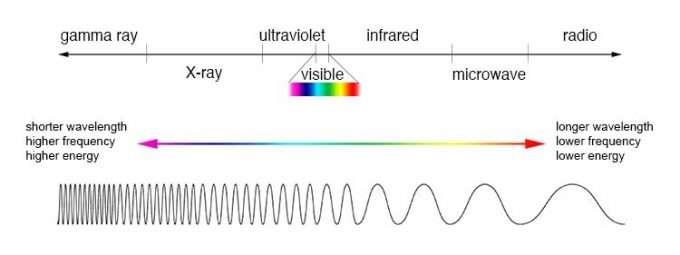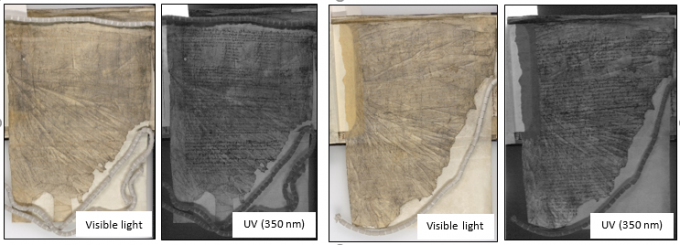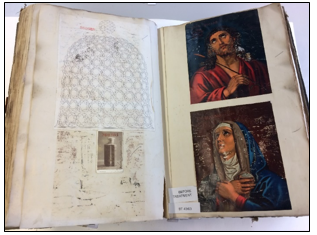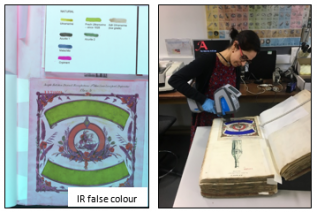This summer, the Collection Care department purchased an innovative multispectral imaging system (MSI). In the simplest sense, this instrument is a high-resolution (150 megapixel) camera, which can capture images in specific ranges of light across the electromagnetic spectrum, as shown in the image below.

The electromagnetic spectrum (c) NASA’s Image the Universe
Images can be taken not just under visible light, but beyond, extending into the ultraviolet (UV) or infrared (IR) range. Using these images we can extract information that is not visible to the human eye. Increasingly, MSI has become a vital tool for investigating cultural heritage objects, because the technology can aid in:
- Pigment, varnish or dye identification
- The detection of underdrawings
- Identifying past conservation treatments
- Identifying deterioration of the materials
- Increasing the readability of damaged documents and documents with faded inks
Traditionally, multispectral images are captured with modified digital cameras that select particular regions of the spectrum. The object is illuminated and optical filters are applied, which are either manually attached to the front lens or a wheel of filters is fitted inside the camera. An array of lights that illuminate the object at a specific wavelength can also be used with a modified digital camera. The images are then stacked, compared and interpreted using post-processing software tools.
Because of the complexity of this process, multispectral imaging is often carried out by imaging specialists. However, we were keen to have an MSI system that is both user-friendly and can be accessed by all of our staff. Our instrument was created by MicroBox GmbH and works in a very different way compared to traditional systems: it uses digital filters and two broadband LED lighting units, creating a streamlined data acquisition process and rapid assessment of images with the push of a button.
As our system is new, it is an exciting time to understand the capabilities of the technology. We are exploring currently how MSI can aid in the understanding, interpretation, and preservation of our collections. Here are some examples of our initial results.
Improving readability
A large proportion of our historical parchment and paper documents are written in iron gall ink. Iron gall ink was the most widely used ink until the 20th century; however, due to its unstable composition, it fades over time and may even damage the material it is written on. Often the text on degraded iron gall ink documents is illegible in visible light, but can be made more legible under UV light.
We are very pleased with the results so far (shown in the image below)! Ensuring access to our collection is central to our mission, so revealing text that has faded beyond our physical ability to read is a significant advancement for our team and our audiences.

Examples of medieval iron gall ink documents with faded inks. When imaged under ultraviolet light (UV) the ink reappears
Pigment identification
Pigment identification is important in the analysis of paintings, prints, and maps. Understanding which colourants were used not only helps us to ensure they are cared for properly, but also is of interest to art historians, historians, and many other researchers. When imaged under UV and IR light, pigments appear differently because of their chemical composition. By comparing the colour of the pigments to a set of standards, multispectral imaging can be used as the first step in the multi-instrumental process to determine an unknown pigment in a drawing or painting.

Example of a BT design register
We are currently exploring this approach within the ‘BT 43 Designs in Demand’ project. The BT (Board of Trade) registers are large volumes of the Patterns, Designs and Trademarks, ranging from 1839 to 1991 and containing almost three million designs.
A long-term project is under way to conserve, analyse, and renew access to these high-demand volumes. Using IR false colour imaging we provisionally identified the blue pigment in one design as French ultramarine.
Additional analysis using X-ray fluorescence spectroscopy, which measures the elemental composition of the pigment, confirmed that this type of blue pigment was used by the designer.
Detection of underdrawings
Infrared radiation, which has longer wavelengths, generally penetrates further than the surface layers of an artwork. This means that when examining a painting or document, shorter wavelengths (such as UV) are often readily absorbed by the outer layers (usually varnishes or inks on paper), while infrared wavelengths pass through the upper layer and interact with the pictorial layer and the underdrawing.
A number of the BT registered designs, posters and maps contain underdrawings, revealing the designer’s creative process. IR radiation can be used to easily detect underdrawings made of carbon (pencils, charcoal, printed ink), because carbon is completely absorbed in infrared radiation, appearing black.
Understanding object structure

Example of infrared false colour imaging and XRF analysis used for pigment identification
As well as UV and IR imaging, we can also investigate the structure of the objects that we image. The MSI system does this by exploiting the differences in the refractive index of different materials to differentiate between structures; for example, we are able to use this imaging technique to observe an artist’s brush strokes.
We can use the same technique to help plan and document practical conservation treatments, as we are able to monitor degradation phenomena, like tide lines caused by water damage. We can also monitor the effectiveness of conservation treatments, for instance to remove historic repairs on paper.

Example of texture imaging to show artist brushstrokes
These are just a few examples of how we intend to use multispectral imaging. We’re very excited about the potential of this technique to reveal new information about The National Archives collections and aid in the understanding of objects in our care.
